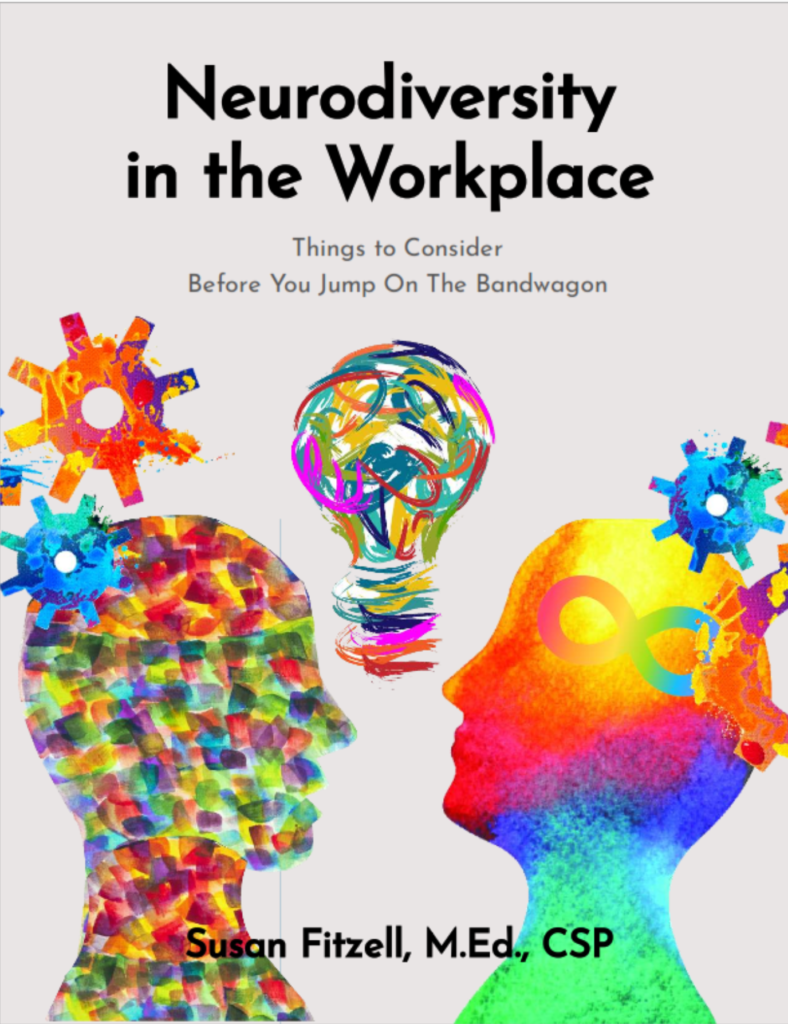By Susan Gingras Fitzell, M.Ed., CSP

Behind the breakneck progress of society, there is one constant – the insurance industry – providing the backbone of security and reassurance required to take on the changing needs and challenges of the future. The insurance sector serves to concentrate the risk inherent to progress.
But it’s no secret that the insurance sector has had difficulty bringing in enough young professionals to carry the industry into this future where its services will be indispensable. Of all the challenges the insurance industry faces, one of the greatest is finding and keeping qualified personnel. Therefore, some attention to neurodiversity in the insurance industry is warranted.
The Hiring and Retention Crisis in the Insurance Industry
The challenge of hiring and retaining quality professionals in the insurance sector is not new. It had been a problem long before the Great Resignation led people to quit their jobs in droves.
In 2012, the Griffith Insurance Education Foundation studied the Millennial generation’s attitudes about the kinds of work they were drawn to. They were particularly interested in how the insurance industry fit into their views as a potential career option.
The results were not very flattering to the industry. The top two reasons people did not want to work in insurance were that they did not want to be an insurance salesperson and because they perceived the industry to be boring.
In my research for this article, I came across countless suggestions and strategies to overcome these misconceptions and attract (and retain) new talent into this industry. There are a lot of great ideas out there:
- create clear job paths for career advancement,
- offer upskilling activities and in-house training (ones that go beyond minimum requirements to keep licenses up to date), and
- embrace remote work when possible.
But there was one solution I rarely saw mentioned, a glaring oversight that could form a crucial part of the insurance sector’s strategy to tackle their hiring and recruitment crisis: hiring neurodivergent workers.
Misconceptions About Neurodiversity in the Insurance Industry
Diversity is a buzzword we frequently hear. For most, the word “diversity” refers to the color of a person’s skin, nationality, physical abilities, age, or maybe even gender or sexual orientation.
Let’s take our understanding up a level. Let’s expand the definition of diversity to include the neurological differences that set some people apart from the norm.
When I use the word neurodiversity, I refer to the broad spectrum of human cognitive ability. Common neurodivergent conditions such as autism, Attention Deficit Disorder with Hyperactivity (ADHD), dyslexia, or Obsessive Compulsive Disorder (OCD) are regularly labeled disabilities. While some people may be more impacted than others by the unique ways their neurodivergence manifests, the word “disability” detracts from the abilities they do have and the ways they can contribute to the workplace.
Other misconceptions haunt neurodivergent (ND) workers as well. Many assume neurodivergent employees are more difficult to train or are less bright than neurotypical workers. It’s a common assumption that they are mentally ill. And it’s an unfortunate stereotype that all divergent thinkers have poor social and communication skills. Worse yet is the belief that they are unlikely to be able to perform essential job duties such as meeting deadlines. While it’s true that these may be issues specific individuals face, these stereotypes create unfortunate obstacles for an entire segment of the human population.
According to an article published by the Centers for Disease Control and Prevention (CDC) in 2021, approximately one out of every forty-four eight-year-olds in the USA is on the autism spectrum. Another recent CDC study estimates that around 6% of all children between the ages of 3 and 17 have an ADHD diagnosis. Yes, those statistics refer to children but keep in mind children grow up and go on and form part of the estimated 15-20% of the worldwide adult population believed to be neurodivergent.
These types of conditions are common. So common that you are most likely working with a neurodivergent coworker without realizing it. Unfortunately, because of a lack of inclusive culture, stigma, and persistent negative stereotypes, many ND individuals hide their conditions in favor of being regarded as neurotypical.
How Divergent Thinkers Benefit the Insurance Industry
ND individuals have unique talents and strengths that can significantly benefit the insurance industry and its many distinct roles.
For example, people on the autism spectrum are frequently blessed with incredible observation skills and analytical thinking and are known for their creative problem-solving capabilities. As if that weren’t impressive enough, there is a common tendency among people on the spectrum to be strongly driven by truth and integrity.
In the insurance sector, people with autism may find great success as actuaries, in loss control or risk management positions, or even as underwriters. Many people with autism are also very adept in roles such as data analysts, financial analysts, accounting, or distinct tech positions.
ADHD and dyslexia also offer specific strengths that can benefit the insurance sector. While each person is unique, many with ADHD have excellent observational skills, are imaginative, and tend to be out-of-the-box thinkers. They also tend to be enthusiastic and energetic in their work, making them ideal candidates for customer service positions. They may also thrive in hands-on roles that take them away from the desk. Those with dyslexia tend to be talented visual thinkers and excellent verbal communicators – also useful for field inspection or jobs in appraisals, not to mention marketing, Human Resources (HR), or sales positions.
A diagnosed neurodivergent condition indicates particular struggles a divergent thinker may contend with. Still, the diagnosis also presents a set of strengths that often counterbalance (and sometimes outweigh) the challenges of their condition.
Embracing Neurodivergence in the Workplace
I’ve only named a few, but there are countless reasons why divergent thinkers should have a role in the insurance industry. But unfortunately, ND individuals regularly have a tough time finding openly inclusive work opportunities.
Most workplaces across all industries are openly hesitant to hire ND workers. According to a study released in 2020 by the Institute of Leadership and Management, about half of all business leaders and managers surveyed were unwilling to hire openly neurodivergent job candidates. Unfortunately, the unemployment rate for the neurodivergent community is estimated to be as high as 40%.
What does all this mean for the insurance industry? It means there is an incredible pool of very talented people just waiting for an opportunity to put their skills to work in meaningful employment.
So how can the insurance sector tap into this talent pool? How can agencies and brokerages of all shapes and sizes reach out and make themselves an attractive career option for the neurodivergent community?
Tips for Embracing Neurodiverse Workers in the Insurance Industry
When deciding to become truly inclusive to all diverse groups, it can take time to figure out where to start. It’s one thing to embrace a new company culture of inclusion, but it’s another to organize the physical workspace and the systems that keep business humming along to support a neurodiverse workforce. The work of nurturing the proper environment for success might sound daunting, but there’s good news: it’s not complicated. Several industry leaders have already cleared the path and can be looked at as examples of creating a more diverse and neuro-inclusive workplace.
Follow the Leaders
Erie Insurance, one of the largest insurers in the US, has recently teamed up with The Precisionists, a company whose sole purpose is to get disabled people into the workforce. The Precisionists (and other companies like them) hire, train, and organize teams made up primarily of autistic individuals to alleviate the unique hiring needs of different companies and corporations. These teams generally work on a contract basis in remote IT and administrative roles. For insurers like Erie, partnering up with this company has been a relatively easy first step toward inclusivity with immediate results. They tap into a highly talented pool of motivated workers for positions they may otherwise struggle to fill.
Companies looking for a quick fix to their hiring problems should consider following industry leaders like Erie in working with companies like The Precisionists, which play an essential role in creating employment opportunities for the neurodivergent community.
Now, if you are looking for a more permanent, in-house solution – where workers are direct hires and not working on a contract basis through a third party – you will need to make some crucial adjustments to your hiring policies. Attracting neurodivergent talent into the insurance industry requires a multifaceted approach. First, you have to know how to reach the right audience.
To start, consider connecting with organizations such as Group for Autism, Insurance, Investment, and Neurodiversity (GAIN), state universities, or other job placement agencies to network specifically with talented ND individuals actively looking for employment within the sector.
Take it to the next level and look at your job descriptions. Are they heavy with soft skill requirements that have little to do with a person’s ability to fulfill the job’s core responsibilities? Consider rewording these job descriptions in ways that will not discourage divergent thinkers from applying.
Next, look at how you are getting your job postings out there. Having a typed-up statement with all the information about an available position is standard procedure. However, it’s essential to make sure you are presenting work opportunities in various formats. Audio and visual job announcements, for example, are more accessible for people who may have difficulty reading but may have an incredible talent with numbers.
And finally, reconsider your interviewing and hiring process. Is it necessary to do a one-on-one interview where a candidate will be judged more by their ability to make eye contact rather than the quality of their work? There are multiple strategies for interviewing neurodivergent job candidates, including informal meet-ups, portfolio-based assessments, or trial projects.
One of the biggest challenges of the Covid-19 pandemic was the sudden overnight shift to remote work. Now that life is returning to normal, more and more businesses are calling their workers back into the office.
Why not consider formalizing work-from-home arrangements? For neurodivergent workers who often struggle with environmental over-stimulation in the workplace, working in the comfort of their home office is a blessing. They are allowed to work more comfortably, and their productivity often skyrockets.If a position can be exclusively done from home, advertise it as such.
This suggestion will benefit any new hire, neurodivergent or not. But for the divergent thinker, having someone they can rely upon and turn to for guidance and reassurance will help them settle into their new position and increase the chances of them choosing to stick around for the long term.
Provide Appropriate Training Materials for Different Learning Styles
One of the most challenging aspects of employment within the insurance industry is staying up to date with the current rules and regulations. The need for constant continuing education and training can be overwhelming for anyone just getting their start in the sector.
In a neurodiverse workplace, all employees will benefit from training and course materials designed for neurodivergent learners. This may include opting for videos and other multimedia presentations or creating study groups to support divergent thinkers in their learning process. No two ND individuals are alike, but fortunately, slews of resources are available to develop training programs that can optimize learning for divergent thinkers in your workplace.
Implement Company-Wide Training and Awareness Programs for All Employees.
Simultaneous with adopting more inclusive policies, it is essential to create awareness programs for neurotypical workers. Unfortunately, if stereotypes and misconceptions about ND workers are left unaddressed, these attitudes lead to a hostile environment of microaggressions or outright bullying. Divergent thinkers must feel welcome in the workplace, and for that to happen, they must feel safe. Consider how team meetings can be exhausting for employees in the neurodiverse workplace. How to communicate to support neurodiversity is critical to corporate teams and small agencies alike.
Adopt “Dynamic Workplace Design™.”
Many business leaders and HR specialists often get hung up on the issue of accommodations. They think bringing on neurodivergent workers will result in expensive adjustments to the work environment, potential resentment among employees who perceive “special treatment,” and endless paperwork to comply with disability law.
All this can be avoided by adopting a workplace culture I like to call Dynamic Workplace Design™. This philosophy embraces the idea that any employee, neurodivergent or not, can freely ask for reasonable accommodations to allow them to do their job better.
Some of these accommodations are easy to implement – noise-canceling headphones available upon request or a more relaxed dress code, for example. Other accommodations like working from home or flexible hours and breaks may be a bit more challenging but are well worth the effort. When all workers, neurodivergent or not, feel supported in attending to their needs, they perform better, and workplace loyalty is likely to increase. Some workplaces are incorporating sensory rooms to support workers who need a calm, low-light quiet space to get a break from the noise and bright fluorescent lights of most office spaces.
For more tips on how a Neurodiverse Friendly Environment Can Give You a Competitive Edge read this article: 3 Ways a Neurodiverse Friendly Environment Can Give You a Competitive Edge When Managing Neurodiverse People
Liberty Mutual Insurance was recently named the Best Place to Work for Disability Inclusion, largely thanks to their willingness to meet the needs of their differently-abled workers through the creation of accessibility councils and expansive employee resource groups.
An accessibility council allows ND workers to advocate for themselves directly with company leaders. Employee resource groups support divergent thinkers in the workplace by helping them understand their rights and the different programs and benefits available to them within the company. They may also offer additional support services to workers and generally work within the organization to foster a culture of inclusion.
Established organizational resources like these put the “walk” in the “talk” of neurodiversity inclusion. Their existence signals ND job candidates that your company is prepared to take their concerns seriously.
Conclusion: Neurodiversity in the Insurance Industry
The above ideas introduce how the insurance industry can embrace neurodiversity and neurodiverse workers into their workforce. They are a starting point for those looking for a creative solution to the chronic issue of hiring and retaining new talent.
Divergent thinkers make up a largely untapped talent pool. They historically make for loyal and dedicated employees when provided with the appropriate support and the accommodations they need to be successful.
There is no one-size-fits-all “neurodiversity package” to sign up for. Each business must honestly assess its internal structure and systems to determine the best game plan for welcoming neurodivergent talent. It’s a process, and you can start that process today with a simple shift in mindset. Open yourself to the possibility that your ideal job candidate may not think like you or may have different social skills than what you’re used to.
Neurodivergent talent may be just what the industry needs to resolve the talent shortage while simultaneously modernizing the sector’s culture to be more inclusive, adaptive, and attentive to the needs of its workers.
References and Recommended Reading:
Centers for Disease Control and Prevention. Attention-Deficit / Hyperactivity Disorder (ADHD) Data and Statistics, 2021. Atlanta, Georgia: US Department of Health and Human Services, Centers for Disease Control and Prevention. Retrieved from: https://www.cdc.gov/ncbddd/adhd/data.html
The Institute of Leadership & Management (2020) Workplace Neurodiversity: The Power of Difference Part 1: Lived Experiences of Neurodivergents. Available from https://www.institutelm.com/resourceLibrary/workplace-neurodiversity-the-power-of-difference.html
Inclusive Hiring: How to Revamp your Company’s Recruitment and Interviewing Process
Leading Effective Team Meetings in the Neurodiverse Workplace https://susanfitzell.com/leading-effective-team-meetings-in-the-neurodiverse-workplace/
Legal Accommodations for Neurodivergent Workers
Maenner MJ, Shaw KA, Bakian AV, et al.(2021) Prevalence and Characteristics of Autism Spectrum Disorder Among Children Aged 8 Years. Autism and Developmental Disabilities Monitoring Network, 11 Sites, United States, 2018. MMWR Surveill Summ;70(No. SS-11):1–16. DOI: http://dx.doi.org/10.15585/mmwr.ss7011a1external icon.)
Millennial Generation Attitudes About Work and The Insurance Industry (2012) The Griffith Insurance Education Foundation.
Sensory Rooms – Facilitating Neurodivergent-Friendly Workplaces https://susanfitzell.com/sensory-rooms%E2%80%8A-%E2%80%8Afacilitating-neurodivergent-friendly-workplaces/
Neurodiversity Definition
Neurodiversity: this term refers to a general diversity of minds. It includes people who are neurotypical and neurodivergent. When I talk about promoting neurodiversity in the workplace, for example, I am referring to creating a diverse workforce representative of the broad spectrum that exists when it comes to ways of thinking, processing information, communication, and learning. Some employees may be “normal” or neurotypical while others may have ADHD, Dyslexia, Autism, or trauma impacted ways of thinking. I am not referring to any particular label or diagnosis, but rather, the concept of an environment where a diversity of minds coexist.
Neurodiverse: This word is pretty much the same as neurodiversity, but should be used as an adjective. You can say, for example, that your workplace is neurodiverse.
Be careful though, because you should never describe a person as being neurodiverse. Individual people should be described as neurodivergent.
Neurodivergent: This word describes an individual whose way of thinking falls outside of society’s defined version of normal. Oftentimes you will see it abbreviated as ND.
Many times, neurodivergent people will have a diagnosis or label you may recognize, like autism, dyslexia, or ADHD. But neurodivergent people are also those with epilepsy, different kinds of brain trauma, or simply a unique way of thinking that may not have a specific diagnosis.
Photo Credit for header image: ipopba / iStockphoto standard license
DOWNLOAD THE NEURODIVERSITY BOOK!
CLICK HERE to visit the articles page.
Bring Susan Fitzell, M.Ed., CSP
Top Neurodiversity Speaker
To YOUR Organization!


